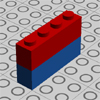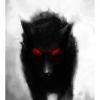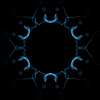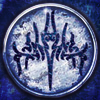Leaderboard
Popular Content
Showing most liked content on 03/13/12 in all areas
-
I would like to announce my paper on Plato's theory of "good" as found and discussed through fantasy books managed to get put up on Peter V Brett's blog. I'm so freaking jacked that an author I enjoy also liked my paper enough to talk about it. Check it out!5 likes
-
Ooh, map stuff! *wrings hands greedily* Ideally, a map should have the more important data stand out from the less important data. The whole point of maps, after all, is to inform the viewer of where things are in relation to other things. Consequently, one thing you don't want to do is color the lines of latitude and longitude. They're helpful, yes, but making them stand out more than they do will add too much noise to the signal, making it harder to read the map. One thing you might want to consider is looking at current atlas maps, (as this map is close to what we recognize these days as atlas maps). You could add light coloration to certain symbols on the map, for example, a light brownish-green for the patches of grass outside of the basin, and a more "healthy" (yet subdued) green for the lines within the basin. You could have the color be right over those symbols, extending only a little bit past them, fading to the background color. Something similar could be done to the earthen terrain of the basin's ridge, too, to show that it's more mountainous. (Ditto for the water along the coastline.) The blue for the river, however, shouldn't be quite so intense. Main waterways like that are important, yes, but since this isn't a navigation chart, the water shouldn't be the aspect that draws one's attention. A more subdued shade of blue should be used there. One thing to keep in mind, then, when choosing what to make stand out and what to subdue is this: "For what purpose did the Canton of Cartography make this map?" Well, we can tell it's not meant to show only general locations, as they have clearly given us latitudinal and longitudinal marks as well as a scale bar. As mentioned before, it's not a navigator's chart. It's also not a map for train engineers or those in that business; rail lines aren't even shown. (Unless, of course, those main "road" lines are actually the primary rail lines.) The CoC is also not trying to show us how the "Greater Elendel Region" relates to the entire planet of Scadrial; the lines of longitude and latitude being nearly parallel indicate that this map has been projected in such a way that all we're concerned with is the Elendel Basin and the nearby surrounding areas. So what did the CoC intend? I think they wanted to show cities, their precise locations, and the routes by which one would get from one to another. Perhaps some planner in the Canton of Travel wanted to see which major cities didn't have convenient access to each other - for example, Rashekin to Steinel. (Or, we could look at the map's title for a clue: "Survey of the Elendel Basin and the Northern Roughts". ) Since there's no legend, the map was not intended for a wide release to the general public; it's intended for a specific audience that already knows what they are looking at/for. With that in mind, you'd want to draw attention to the cities and the roadways (or railways; whatever those lines are). (And you would definitely want to have the city names be on a higher layer than the roadways so you don't have the roads covering up the names as in the cases of Mycondwell and Wyllion.) Brown is probably not the best choice for the roads. If you're actually recreating the lines rather than simply coloring the existing ones, you might want to consider something other than a single, solid line - maybe a single line of two alternating colors, or a thin central line of one color outlined on either side with another color (black?). The city names could be made bold, with an "outer glow" to help them stand out from any background coloration that you might do for the fields within the Basin. Additionally, some words should be made not to stand out. "Elendel Basin", for example, should not stand out more than the city names. The names of the seas can certainly stand out against the water, and the names of the ranges should probably stand out against the terrain they're printed over, but the intended audience already knows about the Elendel Basin and the Northern Roughs, so those shouldn't stand out over the other information. (You can already see how that was implied by the fact that those letters are written with thin lines that break periodically, versus the constant, thick, bold lines showing the city names.) Personally, I think coloring the map is a neat idea. But then, I'm the guy who got a degree in geography with a focus on geospatial information science, so I'm biased.3 likes
-
Ah, just got a response from Isaac about the roads on the map of the Basin. (Quoted here with his permission.)2 likes
-
Perhaps recreating the map might be easier than simple coloring it? Either way, the Cartographer's Guild is a great place to look for resources and help with the actual down-and-dirty of map making.2 likes
-
What do you guys think? Since the planets are in the same universe (do we know if it's the same galaxy?) Is there any chance any of the worlds develop high enough technology to travel between the stars? /oGGe1 like
-
New to the board, only lurked a short time, but I think this is the place. Used the search function for Hoid and Hoid's Shard here and in the WOK forum, but didn't see a similar thought to bump. Hoid is a Sliver, right, having formerly held a Shard. Does he come out and tell Kaladin which Shard that was? WOK, hardcover, 801 "A compliment? Calling someone a thief?" "Of course. I myself am a thief." "You are? What do you steal?" "Pride," the man said, leaning forward... Contextually it might be part of his current role as King's Wit, lancing egos, which he mentions next. It would be stronger if Kaladin had asked "What did you steal?" and Hoid answered "Pride", but it seems a decent question to ask Sanderson.1 like
-
Ah, it sounds like your outlines are much more detailed than mine. Mine just give me enough information to have an idea of where a scene takes place, whose in it, and how it adds to the overall story. The in late out early rule also helps prevent you from getting sidetracked with worldbuilding: there's no time for that when the bomb is about to go off/the deathstar is taking potshots at your fleet/Bruce Banner is getting angry. Anywho, that aside, perhaps taking a different approach to your outline would help? The three act format may help you discard those ideas that you don't need. For me, writing a book is more like adding paint to a canvas, but it sounds like for you it is more like taking stone away from a block in order to produce a statue. I'm still listening through the backlog of Writing Excuses, but I don't think they've really touched upon what I like to call the "quest" version of the three act format. Have you played the game Chrono Trigger? It is an excellent example of this (spoilers follow). The game starts out with a "Minor Quest" (save the Princess), during which the basics of the game and the first Major Quest are established (time travel, the ability to change the future, and Magus). That takes us to the ruined future, where the party finds out that their world is doomed and that Lavos is to blame. They find out that Magus made Lavos, and the First Major Quest is underway! The basics of the second major quest start to appear (a red star, dreamstone, a displaced smith, magic, Ozzie's in a pickle, etc). We fight our way to the top of Magus's castle, have an epic fight, and then the twist: Lavos has a different origin. The party finally has their sights set on the right target and the Second Major Quest then focuses on that. So, when you're writing, it might be useful to consider the Three Quest Format. A minor quest is the thing that will motivate your Heroes to go out into the greater world and discover The First Major Quest. Generally, if find that for epic fantasy, the Major quest is too major to not have a minor quest lead-in. WoT did this with having Rand and the others chased from their home. LotRs did this with Frodo being unexpectedly given the Ring. Even Mistborn did this: Vin's last job for her old gang is the minor quest that put her out into the world and got her noticed by Kelsier and the Major Quest. Of course, then they defeat the Lord Ruler and find out that he was, essentially, their Magus who was protecting them from Scadrial's Lavos. Hopefully that is somewhat useful?1 like
-
1 like
-
Yes, that might be a Shard, and it's opposite would be Depression. that would be a horrible magic system that it would create.1 like
-
If the staff is spiking new people, they are in direct violation of the ShardPact they signed in blood upon Staffdom. Only the Admins have the secrets of Hemalurgy, and only the Admins administer the spikings. Welcome, Jasper. Please report any unauthorized spikings to the Admins, and the violators in question will be dealt with.1 like
-
1 like
-
Also, aluminum foil hats. Very important against rioters, soothers, and space aliens.1 like
-
I would like to announce that I just got my first downvotes. Sadness. Apparently someone didn't like that I used to be a Twilight fan. Two someones in fact. I'm reformed, I swear! I've seen The Light! (Funny, Wheel of Time was the series that pulled me out! Thank The Light indeed!)1 like
-
They are not one Shard, as confirmed by Brandon, during the Alloy of Law signing.1 like
-
1 like
-
What does Kalidan do when he does his lashings? If I remember correctly he closes his eyes. I don't think blinking is the key, only the lack of sight. If I could windbag for a moment. I would say that the lack of sight has some symbolism. How often do our eyes (in fiction) deceive from the truth. If we see something that counters what we know to be true, it could be filtered out. In some magic systems, the act of magic needs to be believed in order to be realized. What is key is the disbelief (however brief) that what they are doing is real. Perhaps in the moment, the act of closing one's eyes accesses the cognitive realm expanding the mind (so to speak) in order to do the magic.1 like
This leaderboard is set to Los Angeles/GMT-07:00










